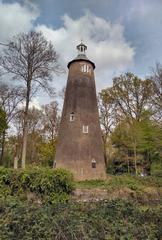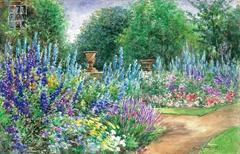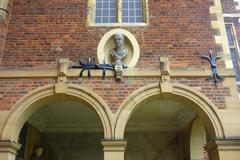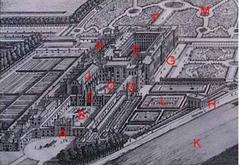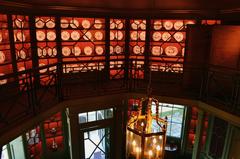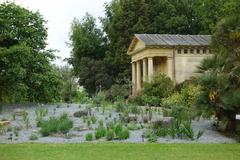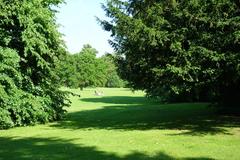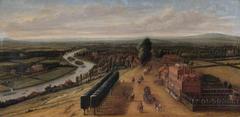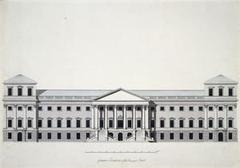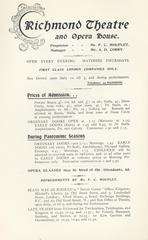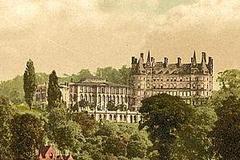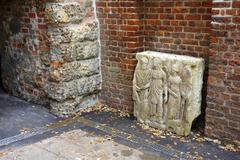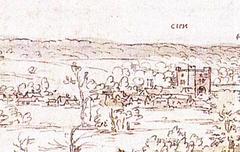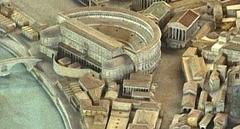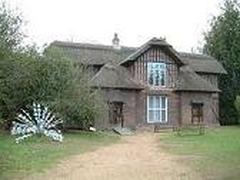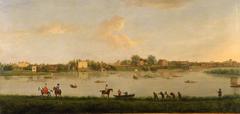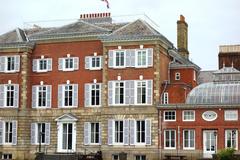Temple of Arethusa, Richmond, United Kingdom: Comprehensive Visiting Guide
Date: 03/07/2025
Introduction: Discovering the Temple of Arethusa
Nestled in the verdant landscapes of Richmond, United Kingdom, the Temple of Arethusa stands as an enduring emblem of 18th-century garden architecture and British cultural heritage. Whether you encounter it in the serene expanse of Richmond Park, the botanical wonders of Kew Gardens, or its riverside setting in North Yorkshire, the Temple of Arethusa captivates with its neoclassical elegance, mythological inspiration, and tranquil surroundings. This guide provides detailed information on visiting hours, tickets, accessibility, historical context, and practical advice, ensuring you make the most of your visit to this iconic site (Richmond Park - The Royal Parks, Kew Gardens, Visit Richmond).
1. Historical Overview: Origins and Significance
Georgian Beginnings
The Temple of Arethusa was commissioned in 1758 by Princess Amelia, daughter of King George II, as part of the transformation of Richmond Park into a landscape of refined beauty and classical references. Named after the mythological Greek nymph Arethusa, who was transformed into a spring, the temple embodies themes of purity, transformation, and harmony with nature. Its construction reflected the Georgian era’s fascination with antiquity, landscape artistry, and the symbolism of classical mythology.
Architectural Features
Built predominantly from Portland stone, the temple features a circular rotunda, Ionic columns, and a domed roof—hallmarks of Palladian and neoclassical design. The structure’s placement takes advantage of sweeping views, particularly over the Thames Valley in Richmond Park, and serves as an ornamental focal point within the garden landscape. The architectural style, inspired by leading figures like William Kent and James Gibbs, signifies the refined taste and intellectual aspirations of the era (Visit Richmond).
Evolution and Preservation
The temple’s role evolved over the centuries—from a private royal retreat to a cherished public landmark. Throughout the Victorian period, it remained a subject for artists and writers. Restoration initiatives in the late 20th and early 21st centuries, supported by English Heritage, have preserved its structural integrity and historic character, allowing future generations to enjoy its beauty.
2. Temple of Arethusa at Kew Gardens
Design and Memorial Purpose
A separate but equally significant Temple of Arethusa stands within the Royal Botanic Gardens, Kew, designed in 1758 by Sir William Chambers for Princess Augusta. As a Grade I listed folly, it exemplifies neoclassical garden architecture. In 1921, it was adapted as a World War I memorial, with an interior plaque honoring local men who lost their lives (Kew Gardens, The Met Museum).
Artistic and Cultural Legacy
The temple at Kew, alongside its landscape, has inspired generations of artists and writers, and remains a site for annual remembrance ceremonies and community reflection. Its mythological and poetic associations enhance the cultural tapestry of Richmond and Kew.
3. The Temple of Arethusa in Richmond, North Yorkshire
Riverside Landmark
Richmond, North Yorkshire, offers another interpretation of the Temple of Arethusa, situated as a folly along the River Swale. Dating back to the 18th century, this monument embodies the Georgian passion for classical forms and picturesque landscapes. It provides a tranquil spot for contemplation and is often featured in walking tours of Richmond’s historic town center (Yorkshire.com).
4. Visiting Hours, Tickets, and Accessibility
Richmond Park (London)
- Opening Hours: Daily from 7:00 AM until dusk (seasonal variations apply; check Richmond Park - The Royal Parks for updates).
- Admission: Free entry to both the park and the temple.
- Accessibility: Paved, wheelchair-friendly paths (some uneven terrain near the monument). Assistance is available upon request.
- Travel: Reachable by public transport (bus and Richmond Station), with cycling routes and parking at key entrances.
Kew Gardens
- Opening Hours: 10:00 AM – 6:00 PM (last entry 5:00 PM), closed December 24–26 (Kew Gardens Tickets).
- Admission: Entry to Kew Gardens (which includes the temple):
- Adults: £19.50
- Children (4–15): £5.00
- Under 4: Free
- Concessions and memberships available; purchase tickets online for convenience.
- Accessibility: Wheelchair-friendly with assistance at entrances; accessible routes to the temple.
Richmond, North Yorkshire
- Access: Outdoor monument accessible year-round, 24/7, with no admission fee or formal hours.
- Parking: Multiple council-run car parks nearby; Richmond Council Car Parks.
- Public Transport: Buses from Darlington (nearest train station, 12 miles away); town center within walking distance.
5. Guided Tours, Events, and Practical Tips
- Guided Tours: Regularly available in Richmond Park and Kew Gardens; local history walks in Richmond, North Yorkshire, often include the temple (Richmond Local History Society).
- Events: Seasonal poetry readings, remembrance ceremonies, and historical reenactments may be held near the temple. Check official event calendars for updates.
- Visitor Tips:
- Facilities: Public restrooms, cafés, and picnic spots in parks and gardens.
- Accessibility: Paths are generally well-maintained; comfortable footwear recommended.
- Photography: The temple offers outstanding photographic opportunities, especially at sunrise and sunset.
- Weather: Bring layers and waterproof clothing; the UK climate is variable (Travelex UK Guide).
- Respect: Please avoid climbing on the monument and dispose of litter responsibly.
6. Nearby Attractions
- Richmond Park: Explore Pembroke Lodge, Isabella Plantation, and panoramic viewpoints.
- Kew Gardens: Visit the Palm House, Great Pagoda, and Rock Garden.
- Richmond, North Yorkshire: Combine your visit with Richmond Castle, the Georgian Theatre Royal, Easby Abbey, and scenic riverside walks.
7. Frequently Asked Questions (FAQs)
Q: What are the visiting hours for the Temple of Arethusa?
A: Richmond Park: 7:00 AM–dusk; Kew Gardens: 10:00 AM–6:00 PM; Richmond, North Yorkshire: accessible 24/7.
Q: Is there an admission fee?
A: Richmond Park and North Yorkshire: Free; Kew Gardens: Standard garden entry ticket required.
Q: Are guided tours available?
A: Yes, check with Royal Parks, Kew Gardens, or local history organizations for schedules.
Q: Is the temple wheelchair accessible?
A: Yes, generally accessible, though some uneven ground may be present.
Q: Is photography allowed?
A: Yes, personal photography is welcome; be mindful during ceremonies or events.
8. Visuals and Media Recommendations
For a richer visitor experience, include high-quality images with descriptive alt text, such as “Temple of Arethusa Richmond historical site.” Maps indicating the temple’s location and virtual tours, where available, are highly recommended.
9. Conclusion: Why Visit the Temple of Arethusa?
The Temple of Arethusa, whether encountered in the royal landscapes of Richmond Park, the storied gardens of Kew, or the riverside beauty of North Yorkshire, offers a unique blend of classical architecture, historical resonance, and natural serenity. Its free or easily accessible entry, proximity to numerous other attractions, and calendar of events make it a rewarding destination for visitors of all ages and interests. Plan your visit using official resources, take advantage of guided tours for deeper insight, and enjoy this timeless gem of British heritage.
Stay updated on events, travel tips, and new discoveries by downloading the Audiala app and following relevant social media channels.
Useful Links and Resources
- Richmond Park - The Royal Parks
- Kew Gardens
- Visit Richmond
- Yorkshire.com
- Richmond Council Car Parks
- Travelex UK Guide
- Rick Steves
- Richmond Local History Society
